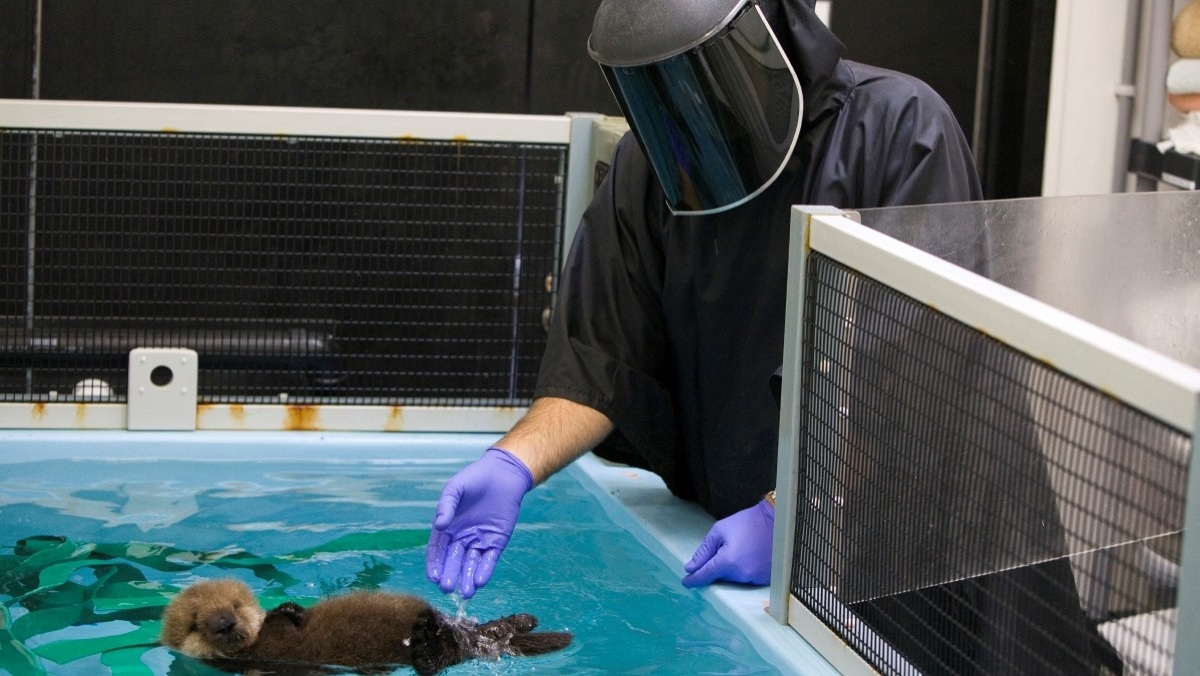The Monterey Bay Aquarium is famous for its exuberant sea otters. But did you know they also rescue orphaned otters and release them back into the wild when they’re ready? The aquarium is also home to many other species. Including deep sea critters few people ever saw in person before the Into the Deep exhibit opened earlier this year. Amongst all the opportunities to see and even touch marine plants and animals, there’s also a few famous filming locations. In just a few hours, you can wander exhibits showcasing life at the beach all the way down to the deep ocean depths. Or even back in time to 1986 when Spock mind-melded with a whale.
This is what we learned on a recent visit to Monterey Bay Aquarium.
Sea Otter Surrogacy
Even if you can’t make it to the aquarium in person, you can watch the sea otters frolic via a live cam. The raft, as a group of sea otters is called, is currently made up of female otters that aren’t able to be released back into the wild. Those that show maternal instincts become surrogate moms to orphaned otters. They teach the baby otters survival skills, like how to groom and hunt.

The aquarium doesn’t name the orphaned otters in their care, referring to them only with numbers. They also don the so-called “Darth Vader suit” when they interact with them. A black poncho and welding helmet ensure that the pups won’t imprint on humans, which could spell disaster for them back in the wild. Most go on to rear their own pups in nearby Elkhorn Slough, where otters help keep the ecosystem healthy. Check out the PBS documentary about Otter 501 for more on this important work.

Deep Sea Exhibit
The new Into the Deep exhibit shows off many creatures that never before displayed in an aquarium. In some cases, scientists who study them had never even seen live specimens, relying on ROV (remotely operated vehicle) footage and collections to learn about them. Some of the lighting in the seafloor tanks of the exhibit mimics ROV headlights, showing off the view we’re used to seeing. There’s sea cucumbers and siphonophores. And even giant isopods you can touch! The water is very chilly since that is what deep sea animals need, but it’s a remarkable experience.
The aquarium’s research and technology partner MBARI uses its ships and ROVs to collect specimens in the canyons of Monterey Bay. Like the bloody belly comb jelly that poops sparkles. Some were collected in other areas of the deep sea, which is anything more than 200 meters (656 feet) below the ocean’s surface. The spider crabs pictured below are examples of the massive size deep sea life is capable of. There’s a live cam of this tank as well. For scale, those are castings of bones from a young sperm whale. The animals on display will rotate during the long-term exhibit’s run, so there’s always a chance to spot something new.

Filming Locations
No visit to Monterey Bay Aquarium is complete without a little pop culture tour as well. The opening credits of Pretty Little Lies includes footage of the Open Sea exhibit. Turtles, sharks, and thousands of sardines make this 1.2 million gallon tank their home. Characters from the show even work at Monterey Bay Aquarium, so there’s after hours and behind the scenes insights as well.
There’s no Sigourney Weaver narration, but there are plenty of similarities to the Marine Life Institute in Finding Dory. That’s because the aquarium provided technical consulting for the Pixar movie. Hank the octopus is even named after one of the staff members!

Only two years after the aquarium opened in 1984, Star Trek IV: The Voyage Home featured key scenes shot there. Though it was named the Cetacean Institute and located north of San Francisco in the film. The outdoor plaza and kelp tank display windows showed off humpback whales key to the plot—as well as Spock taking a quick dip. Even though the aquarium has never housed humpbacks, people still come wanting to see George and Gracie.

One of my favorite exhibits is a tank with an unnamed species of comb jelly. Instead of the usual signage, it says “Hello, my name is ____” and the blank will be filled in once scientists understand more about the tiny red critter. It’s a new discovery and really shows how much we have left to learn about the ocean.
I highly recommend a visit to the Monterey Bay Aquarium. If you’re not able to make it in person, check out the Monterey Bay Aquarium YouTube channel for live cams and other beautiful and educational content.
Featured Image: Monterey Bay Aquarium
Melissa is Nerdist’s science & technology staff writer. Monterey Bay Aquarium has been her happy place since she was a child organizing sea stars at the touch pool. She moderates “science of” panels at conventions and co-hosts Star Warsologies, a podcast about science and Star Wars. Follow her on Twitter @melissatruth.


